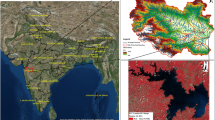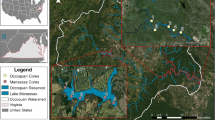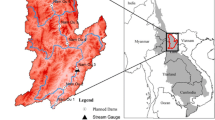Abstract
Reservoir storage is compromised by sedimentation for which reason it has become an important matter in reservoir operation and management. While many studies have investigated sediment deposition rate in reservoirs, few have analyzed reservoir sedimentation from their catchment’s land use change perspective. Based on bathymetric survey conducted on two reservoirs in the White Volta Basin in 2020 and analysis of four Landsat satellite imagery (1986, 1996, 2006, and 2020) within their watersheds, this study assessed the land cover change within the watersheds to draw inferences on the rate of sedimentation of the reservoirs located downstream of their catchments. The results revealed rapid sedimentation in the small-sized reservoir (Vea), with an annual sedimentation rate of 0.304% and a nominal sedimentation rate of 0.17% for the mid-sized reservoir (Tono). Furthermore, the savannah forest within the Vea catchment declined drastically from 29.4% (1985) to 9.9% (2020) influenced by the rapid expansion of farmlands from 18.7% to 47.9% within the same period, respectively. On the other hand, the savannah forest within the Tono catchment declined from 34.7% (1985) to 21.6% (2020) due to farmland expansion from 19.2% to 39% within the same period, respectively. The higher sedimentation rate observed in the small-sized reservoir was observed to be worsened by extensive tree cover removal in its catchment. Therefore, land cover characteristics within a watershed have a significant bearing on the rate of sedimentation in the reservoirs located downstream of their catchment. Hence, adopting a multi-sectorial approach to dealing with land use management is necessary to sustain reservoirs' storage.
Graphical abstract









Similar content being viewed by others
Data availability statement
The data that support the findings of this study are available from the corresponding author (JAA), upon reasonable request. The Landsat images are available at USGS EarthExplorer (https://earthexplorer.usgs.gov).
References
Adongo, T. A., Kugbe, J. X., & Gbedzi, V. D. (2016). Siltation of the reservoir of Vea irrigation dam in the Bongo District of the Upper East Region, Ghana. International Journal of Science and Technology, 4, 2224–3577. http://www.ejournalofscience.org
Adongo, T. A., Kyei-Baffour, N., Abagale, F. K., & Agyare, W. A. (2019). Assessment of reservoir sedimentation of irrigation dams in northern Ghana. Lake Reserv. Manag., 36, 87–105. https://doi.org/10.1080/10402381.2019.1659461
Adwubi, A., Amegashie, B. K., Agyare, W. A., Tamene, L., Odai, S. N., Quansah, C., & Vlek, P. (2009). Assessing sediment inputs to small reservoirs in Upper. Lakes & Reservoirs: Research & Management, 14, 279–287. https://doi.org/10.1111/j.1440-1770.2009.00410.x
African Development Fund (ADF). (2002). Appraisal Report Community Forestry Management Project Republic of Ghana.
Akubia, J. E. K., Ahmed, A., & Bruns, A. (2020). Assessing how land-cover change associated with urbanisation affects ecological sustainability in the Greater Accra Metropolitan Area, Ghana.
Ali, Y. S., Crosato, A., Mohamed, Y. A., Abdalla, S. H., & Wright, N. G. (2014). Sediment balances in the Blue Nile River Basin. Int. J. Sediment Res., 2014(29), 316–328.
Awotwi, A., Yeboah, F., & Kumi, M. (2014). Assessing the Impact of Land Cover Changes on Water Balance Components of White Volta Basin in West Africa Assessing the Impact of Land Cover Changes on Water Balance Components of White Volta Basin in West Africa. https://doi.org/10.1111/wej.12100
Barry, B., Obuobie, E., Andreini, M., Andah, W., & Pluquet, M. (2005). The Volta River basin, assessment, comprehensive management. Water, 1–187.
Birkinshaw, S. J., & Bathurst, J. C. (2006). Model Study of the Relationship between Sediment Yield and River Basin Area, 761, 750–761. https://doi.org/10.1002/esp.1291
Boakye, E., Anornu, G. K., Quaye-ballard, J. A., & Donkor, E. A. (2018). Land Use Change and Sediment Yield Studies in Ghana : Review, 11, 122–133. https://doi.org/10.5897/JGRP2018.0707
Chander, G., Markham, B. L., Helder, D. L., & Ali, E. (2009). Remote Sensing of Environment Summary of current radiometric calibration coef fi cients for Landsat MSS, TM, ETM +, and EO-1 ALI sensors. Remote Sensing of Environment, 113, 893–903. https://doi.org/10.1016/j.rse.2009.01.007
Chanson, H. (1998). Extreme Reservoir Sedimentation in Australia: A Review. Int. J. Sediment Res., 13, 55–63.
Chanson, H., & James, D. P. (2005). Siltation of Australian Reservoirs: Some Observations and Dam Safety Implications. Department of Civil Engineering, The University of Queensland, Brisbane QLD 4072, Australia.
Congalton, R. G. (1991). A review of assessing the accuracy of classifications of remotely sensed data. Remote Sensing of Environment, 37, 35–46. https://doi.org/10.1016/0034-4257(91)90048-B
Congalton, R. G., Gu, J., Yadav, K., Thenkabail, P., & Ozdogan, M. (2014). Global land cover mapping: A review and uncertainty analysis. Remote Sens., 6, 12070–12093. https://doi.org/10.3390/rs61212070
Crowder, B. M. (1987). Economic costs of reservoir sedimentation: A regional approach to estimating cropland erosion damage. Journal of Soil and Water Conservation, 42, 194–197.
Dendy, F. E., & Bolton, G. C. (1976). Sediment yield-runoff-drainage area relationships in the United States. Journal of Soil and Water Conservation, 31(6), 264–266.
Dendy, F. M., Champion, W. A., & Wilson, R. B. (1973). Reservoir sedimentation surveys in the United States. In Man-made lakes: their problems and environmental effects (pp. 349–357). Washington, DC, USA: American Geophysical Union.
Dutta, S. (2016). Soil erosion, sediment yield and sedimentation of reservoir : A review. Model. Earth Syst. Environ., 2, 1–18. https://doi.org/10.1007/s40808-016-0182-y
Forest Services Division (FSD). (2015). Annual report of the Forestry Services Department; Upper East Region; Ghana.
Fries, J. (1991). Management of Natural Forests Semiarid Areas of. Africa, 20, 395–400.
Fries, J., & Heermans, J. (2014). Natural forest management in semi-arid Africa: Status and research needs. Unasylva, 43(2014), 9–15.
Fu, K. D., He, D. M., & Lu, X. X. (2008). Sedimentation in the Manwan reservoir in the Upper Mekong and its downstream impacts. Quaternary International, 186, 91–99. https://doi.org/10.1016/j.quaint.2007.09.041
García-Ruiz, J. M., Regüés, D., Alvera, B., Lana-Renault, N., Serrano-Muela, P., Nadal-Romero, E., Navas, A., Latron, J., Martí-Bono, C., & Arnáez, J. (2008). Flood generation and sediment transport in experimental catchments affected by land use changes in the central Pyrenees. Journal of Hydrology, 356, 245–260. https://doi.org/10.1016/j.jhydrol.2008.04.013
Garzanti, E., Andò, S., Vezzoli, G., Megid, A. A. A., & El Kammar, A. (2006). Petrology of Nile River sands (Ethiopia and Sudan): Sediment budgets and erosion patterns. Earth and Planetary Science Letters, 2006(252), 327–341.
Gebremicael, T. G., Mohamed, Y. A., Betrie, G. D., van der Zaag, P., & Teferi, E. (2013). Trend analysis of runoff and sediment fluxes in the Upper Blue Nile basin: A combined analysis of statistical tests, physically-based models and landuse maps. Journal of Hydrology, 482, 57–68. https://doi.org/10.1016/j.jhydrol.2012.12.023
Ghana Irrigation Development Authority (GIDA). (2010). Final report of the Ghana Social Opportunity Project (GSOP).
Glymph, L. M. (1973). Summary: Sedimentation of reservoirs. In Man-made lakes: Their problems and environmental effects (pp. 342–348). Washington, DC, USA: American Geophysical Union.
Guan, D., Li, H., Inohae, T., Su, W., Nagaie, T., & Hokao, K. (2011). Modeling urban land use change by the integration of cellular automaton and Markov model. Ecol. Modell., 222, 3761–3772. https://doi.org/10.1016/j.ecolmodel.2011.09.009
Hammond, T. O., & Verbyla, D. L. (1996). Optimistic bias in classification accuracy assessment. International Journal of Remote Sensing, 17, 1261–1266. https://doi.org/10.1080/01431169608949085
Harden, C. (1988). Mesoscale estimation of soil erosion in the. Mountain Research and Development, 11(1), 37–55.
HQUSACE. (2002). Engineering and design - Hydrographic surveying. EM 1110-2-1003, U.S Army Corps of Engineers, Washington, DC. Retrieved September 4, 2002, from http://www.HQUSACE.army.mil/inet/HQUSACE-docs/eng-manuals/em1110-2-1003/toc.htm
Hrissanthou, V. (2011). Computation of lake or reservoir sedimentation in terms of soil erosion. In Sediment transport in aquatic environments. Rijeka, Croatia: InTech.
Imagen Consult. (2013). Tono project water availability assessment. Tono Project-Ghana.
Irrigation Development Authority (IDA). (1978). Tono irrigation project. Abrief description.
Jacobsen, T. (1997). Sediment Problems in Reservoirs. Norwegian University of Science and Technology (NTNU).
Johnston, B.S. (2022). Uncertainty in Bathymetric Surveys. Advances 1–25.
Karamage, F., Shao, H., Chen, X., Ndayisaba, F., Nahayo, L., Kayiranga, A., Omifolaji, J. K., Liu, T., & Zhang, C. (2016). Deforestation effects on soil erosion in the Lake Kivu Basin, DR Congo-Rwanda. Forests, 7, 281.
Kawashima, S. (2007). Conserving reservoir water storage: An economic appraisal. Water Resources Research, 43, 1–9. https://doi.org/10.1029/2006WR005090
Kondolf, G. M., Gao, Y., Annandale, G. W., Morris, G. L., Jiang, E., Zhang, J., Cao, Y., Carling, P., Fu, K., Guo, Q., Hotchkiss, R., Peteuil, C., Sumi, T., Wang, H., Wang, Z., Wei, Z., Wu, B., Wu, C., & Yang, C. T. (2014). Sustainable sediment management in reservoirs and regulated rivers: Experiences from five continents. Earth’s Futur., 2, 256–280. https://doi.org/10.1002/2013ef000184
Kundu, S., Khare, D., & Mondal, A. (2017). Past, present and future land use changes and their impact on water balance. Journal of Environmental Management, 197, 582–596. https://doi.org/10.1016/j.jenvman.2017.04.018
Kusimi, J. M. (2008). Analysis of sedimentation rates in the Densu river channel: The result of erosion and anthropogenic activities in the Densu Basin. West African Journal of Applied Ecology, 14, 1–14. https://doi.org/10.4314/wajae.v14i1.44703
Lane, J., & Nichols, M. (1998). Processes controlling sediment yield from watersheds as functions of spatial scale, 9838.
Liu, Y. J., Wang, T. W., Cai, C. F., Li, Z. X., & Cheng, D. B. (2014). Effects of vegetation on runoff generation, sediment yield and soil shear strength on road-side slopes under a simulation rainfall test in the three gorges reservoir area. China. Sci. Total Environ., 485–486, 93–102. https://doi.org/10.1016/j.scitotenv.2014.03.053
López-Serrano, P. M., Corral-Rivas, J. J., & Díaz-Varela, R. A. (2016). Evaluation of radiometric and atmospheric correction algorithms for aboveground forest biomass estimation using Landsat 5 TM data. Remote Sensing, 8, 1–19. https://doi.org/10.3390/rs8050369
Lunetta, R. S., Johnson, D. M., Lyon, J. G., & Crotwell, J. (2004). Impacts of imagery temporal frequency on land-cover change detection monitoring. Remote Sensing of Environment, 89, 444–454. https://doi.org/10.1016/j.rse.2003.10.022
Molla, T., & Sisheber, B. (2017). Estimating soil erosion risk and evaluating erosion control measures. Solid Earth., 8(1), 13–23.
Msadala, V., Gibson, L., Roux, J. Le, Rooseboom, A., & Basson, G. (2010). Sediment yield rrediction for South Africa: 2010 Edition.
Mul, M., Obuobie, E., Appoh, R., Kankam-Yeboah, K., Bekoe-Obeng, E., Amisigo, B., Logah, F. Y., Ghansah, B., & McCartney, M. (2015). Water resources assessment of the Volta River Basin, IWMI Working Papers. https://doi.org/10.5337/2015.220
Namara, R. E., Horowitz, L., Nyamadi, B., & Barry, B. (2011). Irrigation Development in Ghana: Past experiences, emerging opportunities, and future directions. Ghana Strategy. Support Program GSSP Work. Pap. No. 0027 41.
Opoku, E., Macgregor, C. J., Sloan, S., & Sayer, J. (2019). Deforestation is driven by agricultural expansion in Ghana’s forest reserves 5. https://doi.org/10.1016/j.sciaf.2019.e00146
Ottinger, M., Kuenzer, C., Liu, G., Wang, S., & Dech, S. (2013). Monitoring land cover dynamics in the Yellow River Delta from 1995 to 2010 based on Landsat 5 TM. Applied Geography, 44, 53–68. https://doi.org/10.1016/j.apgeog.2013.07.003
Ozesmi, S. L., & Bauer, M. E. (2002). Satellite remote sensing of wetlands. Wetlands Ecology and Management, 10, 381–402.
Poursanidis, D., Chrysoulakis, N., & Mitraka, Z. (2015). Landsat 8 vs. Landsat 5: A comparison based on urban and peri-urban land cover mapping. International Journal of Applied Earth Observation and Geoinformation, 35, 259–269. https://doi.org/10.1016/j.jag.2014.09.010
Qasim, M., Porembski, S., Sattler, D., Stein, K., Thiombiano, A., & Lindner, A. (2016). Vegetation Structure and Carbon Stocks of Two Protected Areas within the South-Sudanian Savannas of Burkina Faso. Environments. https://doi.org/10.3390/environments3040025
Rahmani, V., Kastens, J. H., de Noyelles, F., Jakubauskas, M. E., Martinko, E. A., Huggins, D. H., Gnau, C., Liechti, P. M., Campbell, S. W., Callihan, R. A., & Blackwood, A. J. (2018). Examining storage capacity loss and sedimentation rate of large reservoirs in the Central U.S. great plains. Water (switzerland), 10, 1–17. https://doi.org/10.3390/w10020190
Saavedra, C. (2005). Estimating spatial patterns of soil erosion and deposition of the andean region using geo-information techniques: a case study in Cochabamba, Bolivia. Ph.D. Thesis, Wageningen University, Wageningen, The Netherlands.
Schleiss, A. J., Franca, M. J., Juez, C., & De Cesare, G. (2016). Reservoir sedimentation. Journal of Hydraulic Research, 54, 595–614. https://doi.org/10.1080/00221686.2016.1225320
Smetanová, A., Müller, A., Zargar, M., Suleiman, M. A., Gholami, F. R., & Mesoscale, M. M. (2020). Mapping of Sediment Source Hotspots for Dam Sediment Management in Data-Sparse Semi-Arid Catchments. Water, 2020(12), 396.
Smith, W. O., Vetter, C. P., Cummings, G. B. (1960). Comprehensive survey of sedimentation in Lake Mead, 1948–49. Washington, DC, USA: US Government Printing Office.
Sundborg, A. (1992). Lakes and Reservoir Sedimentation Prediction and Interpretation. Lakes & Reservoirs: Research & Management.
Tate, E. L., & Farquharson, F. A. K. (2000). Simulating reservoir management under the threat of sedimentation: The case of Tarbela dam on the River Indus. Water Resour. Manag., 14, 191–208. https://doi.org/10.1023/A:1026579230560
USGS. (2020). Frequently asked questions, from USGS Water-Science School. 27 June 2021.
Vanmaercke, M., Poesen, J., Broeckx, J., & Nyssen, J. (2014). Sediment yield in Africa. Earth-Science Reviews, 136, 350–368. https://www.usgs.gov/faqs/what-are-band-designations-landsat-satellites
van Vliet, J., Bregt, A. K., & Hagen-Zanker, A. (2011). Revisiting Kappa to account for change in the accuracy assessment of land-use change models. Ecol. Modell., 222, 1367–1375. https://doi.org/10.1016/j.ecolmodel.2011.01.017
Venot, J. P., de Fraiture, C., & Acheampong, E. N. (2012). Revisiting dominant notions: A review of costs, performance and institutions of small reservoirs in sub-Saharan Africa. IWMI Research Report. Doi, 10(5337/2012), 202.
Walling, D. E. (1999). Linking land use , erosion and sediment yields in river basins. Hydrobiolgy, 410, 223–240.
Wang, G., Wu, B., & Wang, Z. Y. (2005). Sedimentation problems and management strategies of Sanmenxia Reservoir, Yellow River. China. Water Resour. Res., 41, 1–17. https://doi.org/10.1029/2004WR003919
Wardell, D. A., Reenberg, A., & Christian, T. (2003). Historical Footprints in Contemporary Land Use Systems : Forest Cover Changes in Savannah Woodlands in the Sudano-Sahelian Zone, 13, 235–254. https://doi.org/10.1016/S0959-3780(03)00056-6
Wilson, G. L., & Richards, J. M. (2006). Procedural documentation and accuracy assessment of bathymetric maps and area/capacity tables for small reservoirs. U.S. Geological Survey.
Yuan, H., Shi, Q., Xiaoying, L., Jinming, X., Dan, L., & Hui, Z. (2015). Sediment management decision making of the Sanmenxia reservoir based on RESCON model 10. https://doi.org/10.5897/AJAR2015.9722
Acknowledgements
This study was funded by the Regional Water and Environmental Sanitation Center Kumasi (RWESCK). At the Kwame Nkrumah University of Science and Technology, Kumasi with funding from the Ghana government through the World Bank under the Africa Centers of Excellence project. Many thanks to the Irrigation Company of the Upper Region (ICOUR) for their data assistance and guidance in the Bathymetric process.
Funding
Funding was provided by the Ghana government through the World Bank.
Author information
Authors and Affiliations
Contributions
Conceptualization, data curation, and visualization were done by JAJ. Writing of the first draft and editing were performed by JAJ and MAA. Supervision, further editing, reviewing, and validation were done by AAK, EDJO, CG, and OSN. All authors read and approved the final manuscript.
Corresponding author
Ethics declarations
Conflict of interest
The authors declare that they have no known competing financial interests or personal relationships that could have appeared to influence the work reported in this paper.
Additional information
Publisher's Note
Springer Nature remains neutral with regard to jurisdictional claims in published maps and institutional affiliations.
Rights and permissions
Springer Nature or its licensor holds exclusive rights to this article under a publishing agreement with the author(s) or other rightsholder(s); author self-archiving of the accepted manuscript version of this article is solely governed by the terms of such publishing agreement and applicable law.
About this article
Cite this article
Atulley, J.A., Kwaku, A.A., Gyamfi, C. et al. Reservoir sedimentation and spatiotemporal land use changes in their watersheds: the case of two sub-catchments of the White Volta Basin. Environ Monit Assess 194, 809 (2022). https://doi.org/10.1007/s10661-022-10431-y
Received:
Accepted:
Published:
DOI: https://doi.org/10.1007/s10661-022-10431-y




